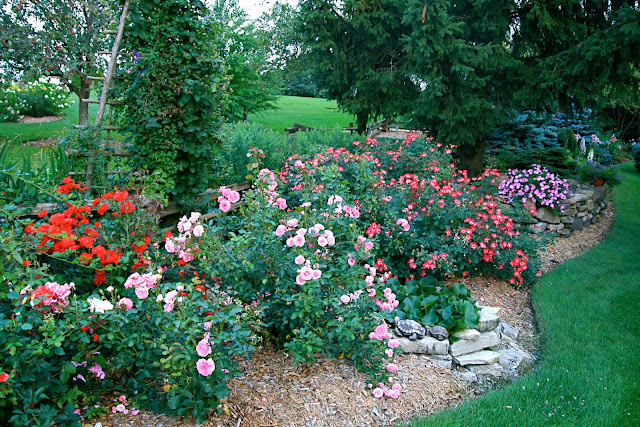(This is a reposting from February 7th, regarding the Tiffany Reproduction Rosebush Shade)
Roses as a subject in lamp shades were somewhat neglected, when compared to other flowers, by Tiffany Studios. I mentioned in an earlier blog that Tiffany really didn’t care for ‘improved’ flowers and was not excited about the hybrid roses coming into style around the turn of the century. Perhaps one reason is that much of the fragrance was being bred out of the hybrids. This is an issue which has been revisited a lot over the last several years, and it accounts for much of the renewed interest in shrub roses.
There apparently weren’t a lot of rose design shades produced. There is a ‘rambling rose’ which has a globe shape with a 16” diameter, and a 16” wild rose design. There was also a cone shaped yellow rose with a 16” diameter. There was a larger briar rose design that was in production for only four years and some other larger diameter examples of roses created as special orders.
The best known rose shade however, is the 24” rosebush sometimes referred to as a rose helmet. I created the one pictured below about a year ago. You often see this shade suspended upside down as a ceiling fixture and it is very effective in that situation as well.
Tiffany glass can be appreciated in transmitted light of course, as with the windows which come alive with the light from outside. Lamps rely on light sources from within... the earliest Tiffanys were lit by gas flame. This was followed by the early Edison filament light bulbs which are still available today. They give off a wonderful light of perhaps twenty-five watts, which works beautifully with many Tiffany style lamps. These bulbs last a very long time, but they are expensive. Some glass however, can have a totally different look in reflected light. Tiffany Studios occasionally used dichroic glass in some of their shades. This glass might have a tan, amber, or beige appearance in reflected light, and the color is strikingly different and beautiful with the addition of transmitted light.
I mention all this because I want to show you an example of my glasswork, involving a huge variation of appearance, when viewed in transmitted versus reflected light. Look at these photos of the 24” rosebush. This shade is equally as effective when unlit as when lit, in my opinion. Additionally it appears as two different shades depending on the light source, reflected or transmitted.
Here I have the pieces still on the glass easel and in reflected light. It was quite an undertaking to deal with the shading in these rose petals, and to my mind, the shading is what makes a good rosebush shade.
Now, still tacked with poster tack to the glass easel (black dots), transmitted light is added from outside… yes it is the same shade!
The next photo shows the completed shade in reflected light.
The final photo shows the shade in transmitted light from the bulb source. At first I was unhappy with the way this glass changed color, but after a time I realized that it was effective both ways. Actually some of the Tiffany shades can look somewhat dull when not lit, but really come to life when turned on. This particular glass is quite attractive in both situations. With glass, such as used in my rosebush, it’s almost like getting two shades for the price of one! I can’t complain about that!
By the way, this shade is featured in ASGLA's (Association Of Stained Glass Lamp Artists) 2010 calendar. This group has over 700 members in 25 countries and 46 states, and the calendar is sold internationally. LC










0 nhận xét:
Đăng nhận xét